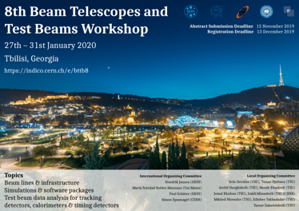Speaker
Description
The Analogue Hadron Calorimeter (AHCAL) developed by the CALICE collaboration is a scalable engineering prototype for a Linear Collider detector. It is a sampling calorimeter of steel absorber plates and 3$*$3 cm$^2$ plastic scintillator tiles read out by silicon photomultipliers (SiPMs) as active material (SiPM-on-tile). The front-end chips are integrated into the active layers of the calorimeter. They are designed for minimal power consumption by rapidly cycling the power according to the beam structure of a linear accelerator. In 2017 and 2018, a new large prototype with 38 active layers of 72$*$72 cm$^2$ size has been built. Each active layer contains 576 single channels, arranged on four readout boards and grouped according to the 36-channel SPIROC2E readout chips. The prototype has been assembled using techniques suitable for mass production, such as injection-moulding and semi-automatic wrapping of scintillator tiles, assembly of scintillators on electronics using pick-and-place machines and mass testing of detector elements. The calorimeter was commissioned at DESY and took muon, electron and pion data at the CERN SPS.
The contribution gives an overview of the construction, commissioning, calibration and first test beam results of the large CALICE AHCAL engineering prototype.




